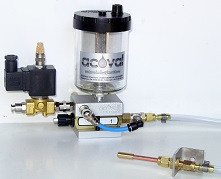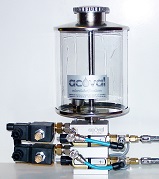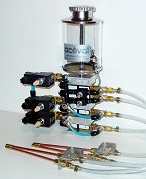Way of functioning
ACOVAL microlubrication systems of the type PULS are instantaneous lubrication systems. They deliver an amount of liquid each time they are activated.
They can be used:
- (1): to deliver an amount of liquid without using air to drive the liquid
- (2): most often with a nozzle which focuses or sprays the liquid with compressed air.
Duty cycle
In he case (1) where an amount of liquid is delivered without using compressed air to drive the liquid, it is important to take into account the
superficial tension phenomenon.
The driving duration and the time interval between two drives must allow an accurate working of micropumps.
In the case (2) where a nozzle focuses or sprays liquid, the driving duration of the system must be:
- the same as the time required to spread the liquid (sample: a 3 seconds machining operation)
- enough to allow the air pressure to establish at the nozzle and to treat the amount of liquid delivered by micropumps.
The time interval between two drives must be enough to allow a correct system initialisation.
Applications
ECOPULS systems
are often used:
- to make short time spaced machining operations
- to lubricate forming operations when the load is manual
- to lubricate assembly operations.
Applications at high pace
Typical samples concern cutting, stamping and high pace machining operations.
The user often want a system of type PULS to work at the same rate as his equipment (his press or his machine tool). It is often a mistake because:
- The number of delivered liquid quantities is so large that the liquid flow may be too important even with low capacity micropumps.
- The compressed air pressure may not be able to take a good place in the nozzle. The functioning may be disturbed.
So it is better to use a system of the type ECOFLUX or ACOFLUX with a lower speed. The gas spreads the liquid out all along the time.
Models
These models without a cabinet
generally include between one and six micropumps.
The liquid flow of each micropump is adjustable.
There is only one air flow setting or an air flow setting for each nozzle.
Standard configurations
These systems are fitted with:
- a 300 ml tank
- for each micropump:
- a 1.5 meter transparent coaxial hose
- a copper coaxial nozzle with its fastening
Standard options
- 0.5 ; 1 ; 2 ; 3 ; 5 ; 9 ; 10 litre tank
- Low level switch
- Automatic filling device
- Micropump selection by groups
- Attachment magnet under the system
- Attachment magnets for the nozzles
- Half capacity micropumps
- Double capacity micropumps
- VITON seals
- Stainless steel sheathed coaxial hoses
- Nozzles
Samples
EP1E
 |
- a micropump
- a solenoid valve
- a 300 ml tank
- a transparent coaxial hose
- a 50 mm copper coaxial nozzle.
|
EP7E
 |
- seven micropumps
- a solenoid valve
- an one litre tank
- seven transparent coaxial hoses
- seven nozzles.
|
EP2E-2E
 |
- two micropumps
- two solenoid valves
- a two litre tank with a low level switch
- two stainless steel sheathed coaxial hoses
- two nozzles
- independent driving of the micropumps.
|
EP4E-4E-V
 |
- four micropumps
- four solenoid valves
- an one litre tank
- four transparent coaxial hoses
- four nozzles
- independent driving of the micropumps.
|
EP4E-3E
 |
- four micropumps
- three solenoid valves
- an one litre tank with a low level switch
- four transparent coaxial hoses
- micropumps driven in three groups
- four 200 mm copper coaxial nozzles.
|







